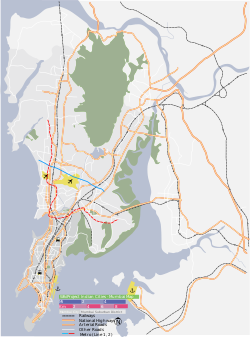Kamathipura
| Kamathipura | |
|---|---|
| neighbourhood | |

A lane in Kamathipura
|
|
| Location in Mumbai, India | |
| Coordinates: 18°58′N 72°49′E / 18.96°N 72.82°ECoordinates: 18°58′N 72°49′E / 18.96°N 72.82°E | |
| Country |
|
| State | Maharashtra |
| Metro | Mumbai |
| Elevation | 4 m (13 ft) |
| Languages | |
| • Official | Marathi |
| Time zone | IST (UTC+5:30) |
Kamathipura (also spelled Kamthipuram) is Mumbai's oldest and Asia's second largest red-light district. It was first settled after 1795 with the construction of causeways that connected the erstwhile seven islands of Bombay. Initially known as Lal Bazaar, it got its name from the Kamathis (workers) of other areas of the country, who were labourers on construction sites. Due to tough police crackdown, in the late 1990s with the rise of AIDS and government's redevelopment policy that helped sex workers to move out of the profession and subsequently out of Kamathipura, the number of sex workers in the area has dwindled. In 1992, Bombay Municipal Corporation (BMC) recorded there were 50,000 sex workers here which was reduced to 1,600 in 2009, with many sex workers migrating to other areas in Maharashtra and real estate developers taking over the high-priced real estate.
The ground floors open directly onto the road like native shops. In their lower and upper rooms, native women call to male passers-by.
After the completion of the Hornby Vellard project in 1784, which built a causeway uniting all seven islands of Bombay under William Hornby, governor of Bombay (1771-1784), plugged the Great Breach in Mahalaxmi, while the subsequent Bellasis Road causeway joined Mazagaon and Malabar Hill in 1793. This resulted in several low-lying marshy areas of Mumbai Flats like Byculla, Tardeo, Mahalaxmi and Kamathipura opening up for habitation. Thereafter starting 1795, Kamathis (workers) of other areas of the country, working as labourers on construction sites began settling here, giving the area its present name. It was bounded by Bellasis Road on the north, by Grant Road on the south and the main road across, Falkland Road. At one point during this period it was home to a Chinese community, which worked as dockhands and ran restaurants. By the late 19th century it all changed.
...
Wikipedia

